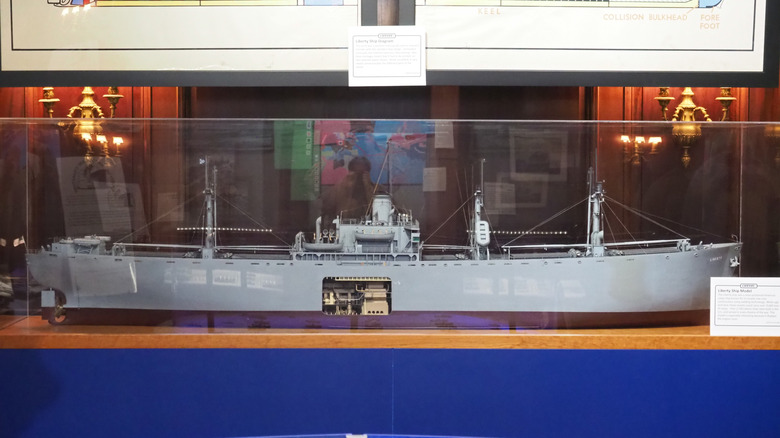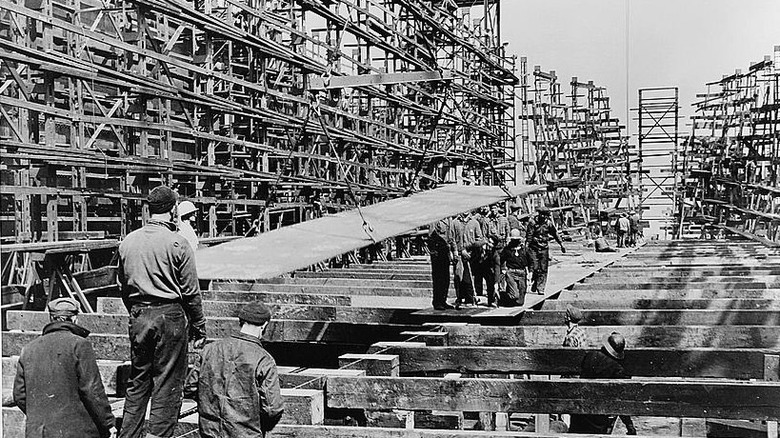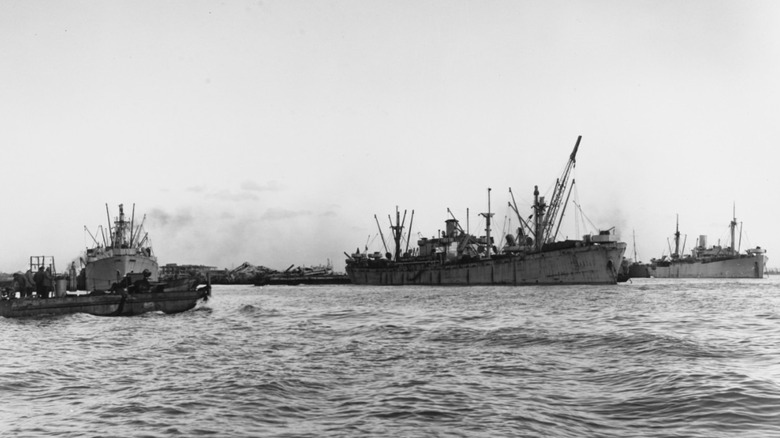Why Liberty Ships Are Some Of The Most Important Vessels Of World War 2
At the turn of the 1940s, World War 2 was in full swing, with the Allied and Axis forces doing battle across Europe, Africa, and the Pacific Ocean. The United States hadn't gotten directly involved in the conflict yet, but it was still looking for ways to aid the Allies outside of combat. The solution that was eventually landed upon was a series of mass-produced, quick-launching shipping vessels that could get vital supplies to the Allied forces around the world. These shipping vessels were collectively known as the Liberty ships.
While the Liberty ships aren't as impressive from a military standpoint as the most legendary ships of World War 2 like the HMS Prince of Wales or the German Tirpitz, these vessels helped keep the war machine running on in the face of overwhelming shipping difficulties. It was the sheer speed with which Liberty ships could be built and their tremendous numbers that allowed them to weather the gunfire and get food, ammo, and even troops where they needed to go.
Liberty ships were mass-produced to meet mid-war shipping needs
Prior to the outbreak of World War 2, the United States had a bit of a problem: its merchant ships were old and falling apart. Whether they were hauling dry cargo or passengers, these vessels were at the end of their proverbial ropes and couldn't withstand the rigors of international trade anymore. In an effort to revitalize American mercantile, the Merchant Marine Act of 1936 was passed to develop and maintain a fresh line of merchant vessels. As it happened, a few years later in 1939, the United States suddenly had a very good reason to pick up the pace on development with the outbreak of World War 2.
The United States' harbors began cranking out vessels like never before, but the increasing danger of international waters from threats like German U-Boats and other submarines meant that building elaborate ships would just be a waste of money. Instead, shipbuilders drafted plans for a mass-produced, factory-made vessel that could get from keel to seaworthy in a fraction of the usual time, with the fastest record being less than a week. These designs, signed off on by President Franklin D. Roosevelt, were meant to bring "liberty" back to the struggling European territories, and thus were named the Liberty ships. Though, while checking out the blueprints, Roosevelt offhandedly commented that the ships were rather drab looking, calling them "ugly ducklings," which became one of their primary nicknames.
The Liberty ships sent supplies and troops around the world
Aesthetically iffy though they were, the Liberty ships became the cornerstone of the United States' World War 2-era merchant operations. An unprecedented 2,710 Liberty ships were built over the course of the war, swapping quality out for sheer quantity. That quantity proved invaluable, as this massive fleet of mass-produced ships saw use both before and after the United States entered the war for shipping vital supplies like food, ammunition, fuel, and medicine. Even troops themselves saw themselves shipped to the front line aboard Liberty ships.
While the Liberty ships were invaluable to the Allies' ultimate victory, it was not without difficulty and tragedy. Once the Liberty ships began rolling out en masse, they were swiftly recognized and deliberately targeted by U-Boats, destroyer ships, and battling aircraft carriers prowling the shipping lanes, not to mention hazards like floating mines. Operating a merchant vessel became one of the most dangerous maritime professions of the era, with around 1 in 26 merchant mariners killed by Axis attacks before the war's end. This is also why, of the 2,710 Liberty ships produced, only three have survived into the modern era. By 1943, the Liberty ships could no longer keep up with rapidly advancing naval technology, which necessitated another whirlwind of shipbuilding. This resulted in the Victory ships, which would ultimately carry the Liberty ships' mission into the end of the war in 1945.


